Choosing the right plastic for food containers can feel like a high-stakes decision. You worry about cost, performance, and safety, knowing that a single wrong choice could jeopardize an entire project. Imagine your container warping in the microwave or cracking in the freezer, or worse, blowing your budget on the wrong material. Understanding the key differences between HDPE and PP is the first step to making the right call every time.
For food containers, Polypropylene (PP) is often preferred for its higher heat resistance, making it ideal for hot-fill applications and microwave use. It’s also stiffer and can be made clearer. High-Density Polyethylene (HDPE) excels in cold temperatures, remaining durable in freezers, and often comes at a lower cost with great chemical resistance. The best choice depends on whether your container needs to handle heat (PP) or cold and chemicals (HDPE), and your budget.
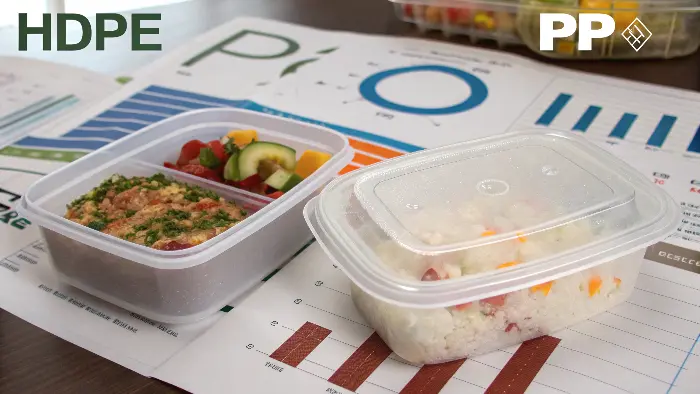
That’s the quick answer, but the real story is in the details. As a designer or engineer, you know that properties like stiffness, performance under extreme temperatures, and the true cost-per-part are what really matter. A surface-level understanding isn’t enough when product quality and budget are on the line. Let’s break down these materials piece by piece so you can see exactly how they stack up for your specific needs.
Is PP stiffer than HDPE?
Your new container design requires a certain level of rigidity to feel high-quality and perform well, but you’re not sure if HDPE or PP will deliver. A container that feels flimsy can damage your brand’s reputation, while a material that’s too brittle could crack under the stress of stacking or daily use. Let’s look at the data and the real-world feel to see which material provides the stiffness you need.
Yes, Polypropylene (PP) is significantly stiffer than High-Density Polyethylene (HDPE). PP has a higher flexural modulus, which is the technical measure of a material’s resistance to bending. This means PP containers feel more rigid and are less likely to deform under pressure. While HDPE is known for its toughness and impact resistance, it is inherently a more flexible material. This is a critical distinction when designing parts that need to maintain their shape.
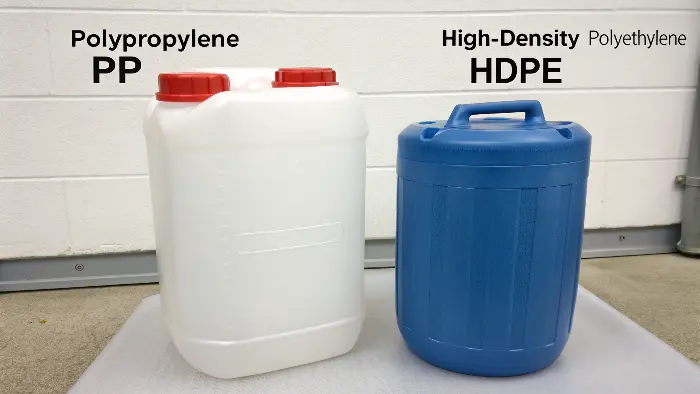
When I talk about stiffness, I’m really talking about a material’s ability to hold its shape. This is one of the most fundamental properties we look at in mold design. The technical term we use is "flexural modulus." A higher number means more stiffness.
Understanding Flexural Modulus
Think of it like this: if you take a thin sheet of both HDPE and PP, the HDPE sheet will be much easier to bend and flex. The PP sheet will resist that bending force more. This isn’t just about how the container feels in the hand; it has major implications for the design of the product itself.
Here is a simple table to show the typical values.
| Material | Typical Flexural Modulus (MPa) | What This Means in Practice |
|---|---|---|
| Polypropylene (PP) | 1300 – 1800 | Higher stiffness, resists bending, feels more rigid. |
| High-Density Polyethylene (HDPE) | 800 – 1500 | More flexible, better for absorbing impacts, feels softer. |
Practical Implications for Design
This difference in stiffness directly impacts your design choices. Because PP is stiffer, you can often design containers with thinner walls while achieving the same level of rigidity as a thicker-walled HDPE part. Thinner walls mean less material used per part, which can lead to significant cost savings, especially in high-volume production. This can sometimes offset the slightly higher raw material cost of PP.
I remember a project for a client making stackable storage bins for a workshop. We initially prototyped with HDPE because it was cheaper. But when we stacked the bins five high, the ones at the bottom started to bow outwards under the weight. The product just didn’t work as intended. We switched to a specific grade of PP with a high flexural modulus. The new bins were incredibly strong, stacked perfectly, and we were even able to thin out the walls slightly. It’s a perfect example of how choosing a material based on its stiffness is crucial for the final product’s function.
How does temperature affect HDPE and PP performance?
You need a food container that can go from the freezer to the microwave without failing. This is a common requirement, but a huge technical challenge. Imagine a customer’s frustration when their container melts while reheating food, or shatters when dropped after being taken from the freezer. This is a safety and quality nightmare that can be avoided by choosing the right material from the start. Let’s examine how both HDPE and PP handle the extremes of hot and cold.
Polypropylene (PP) has a major advantage in heat resistance, with a melting point around 165°C (329°F), making it safe for microwaves and hot-fill processes. However, standard PP can become brittle near freezing temperatures. In contrast, High-Density Polyethylene (HDPE) performs exceptionally well in the cold, remaining tough and ductile down to -50°C (-58°F). Its weakness is heat, as it begins to soften around 125°C (257°F) and is not suitable for microwave use.
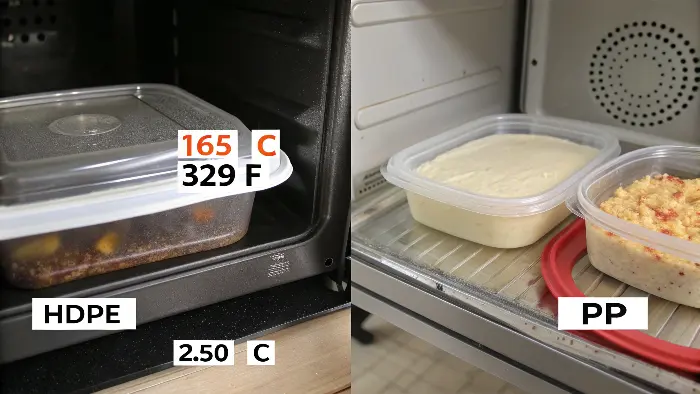
Temperature resistance is not a single property; it’s a tale of two extremes. A material that excels in the heat might fail spectacularly in the cold, and vice-versa. For food containers, this is one of the most important trade-offs to consider.
High-Temperature Performance: The PP Advantage
When we talk about high temperatures in food packaging, we’re usually talking about three things: hot-filling, autoclaving (sterilization), and microwaving. PP is the champion in all three areas. Its higher melting point and Vicat softening point (the temperature at which it starts to deform under a load) mean it can be filled with hot liquids like sauces or syrups right off the production line. It can also be sterilized with high-pressure steam and, most importantly for the consumer, it can be used to reheat food in the microwave without warping or melting. HDPE simply cannot handle this level of heat.
Low-Temperature Performance: The HDPE Domain
Now let’s go to the other end of the thermometer. If your product is going to be stored in a freezer, like ice cream or frozen vegetables, HDPE is the clear winner. The key property here is the "brittleness temperature." This is the point where a plastic loses its ductility and becomes fragile like glass. For standard PP, this can happen right around the freezing point of water (0°C). For HDPE, that temperature is much, much lower. It stays tough and impact-resistant even in deep-freeze conditions, preventing it from cracking or shattering if dropped.
| Property | Polypropylene (PP) | HDPE | Application Relevance |
|---|---|---|---|
| Melting Point | ~165°C (329°F) | ~130°C (266°F) | Determines suitability for hot-fill & microwave. |
| Brittleness Temp. | ~0°C (32°F) | < -50°C (-58°F) | Determines performance in freezers. |
| Vicat Softening Point | ~155°C (311°F) | ~125°C (257°F) | Point of significant softening under heat and load. |
A client once wanted to launch a line of microwaveable soups. They were leaning towards HDPE because the raw material cost was lower. I insisted we run a simple test. We filled both an HDPE and a PP container with water and put them in the microwave for 90 seconds. The PP container was fine, but the HDPE container had slumped and deformed badly. That simple test saved them from a massive product recall and protected their brand’s reputation.
Is PP more expensive than HDPE?
You are trying to manage your project budget, and the cost of raw materials is a huge variable that can make or break your profitability. Choosing the more expensive material without a clear, functional reason can kill your margins. But choosing the cheaper one just to save money could lead to product failure, customer complaints, and even higher costs in the long run. Let’s break down the real cost difference between HDPE and PP.
On a simple price-per-kilogram basis, High-Density Polyethylene (HDPE) is almost always less expensive than Polypropylene (PP). This makes HDPE the go-to choice for many high-volume, cost-sensitive products. However, the final cost of the molded part can be more complex. PP is less dense and stiffer, which may allow for designs with thinner walls. This can reduce the total amount of material used, potentially offsetting the higher initial price and making the final part cost very competitive.
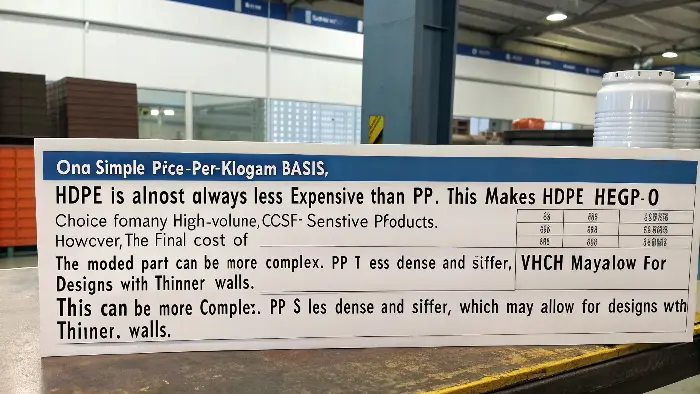
I always tell my clients, don’t just look at the price list from the material supplier. The price per kilogram is only the beginning of the story. To understand the true cost, you have to think like a mold maker and calculate the final "cost-per-part." Several factors play into this.
Raw Material Price vs. Part Cost
First, yes, the raw material cost for HDPE is typically 5-15% lower than for PP. For a product like a milk jug, where millions are made and cost is the primary driver, this difference is everything. But for more specialized containers, other factors come into play.
The "Cost-per-Part" Calculation
This is where a good designer can save a lot of money. Here’s what we look at:
- Density: PP is one of the lightest commodity plastics, with a density of about 0.905 g/cm³. HDPE is denser, at about 0.95 g/cm³. This means that for every kilogram of plastic you buy, you get more volume of PP than HDPE. You can physically make more parts from a kilogram of PP, assuming the parts are identical.
- Wall Thickness: This connects back to stiffness. Because PP is stiffer, you can often design the part with thinner walls and less structural ribbing. If you can reduce the material in each part by 10%, that’s a direct 10% saving on material cost for that part, which can easily erase the initial price difference.
| Factor | Polypropylene (PP) | HDPE | Impact on Final Cost |
|---|---|---|---|
| Price per kg (Example) | $1.20 | $1.10 | HDPE is cheaper by weight. |
| Density (g/cm³) | ~0.905 | ~0.95 | PP yields more volume per kg. |
| Required Wall Thickness | Can often be thinner | May need to be thicker for same rigidity | PP can save material per part. |
| Final Part Cost | Can be very competitive | Often the lowest cost option | A detailed design analysis is required. |
We had a client developing a new line of cosmetic jars. The initial plan was to use HDPE. I suggested we also quote it in PP. We ran a mold-flow analysis and redesigned the part for PP, taking advantage of its stiffness to thin the walls. Even though the PP material was 10% more expensive per kilogram, the final part was 5% cheaper because it used 15% less plastic. That’s the kind of practical insight that makes a huge difference to the bottom line.
What is the difference between PP and HDPE bottles?
You see both PP and HDPE bottles on the shelf every day, but what really sets them apart in a practical sense? When you’re designing a bottle, choosing the wrong material could mean a cloudy bottle when you wanted it to be clear, or a bottle that can’t handle your product’s filling process. Let’s look at some real-world examples to see the key functional and aesthetic differences that will guide your choice.
The most visible differences are in clarity, temperature resistance, and flexibility. HDPE bottles, like milk jugs, are naturally milky-white or opaque, very tough, and great for cold products. PP bottles can be made with much higher clarity (contact-clear), are more rigid, and can withstand hot-filling and sterilization. This makes PP ideal for things like clear syrup bottles or medical containers. HDPE is more flexible and squeezable, while PP is stiffer.
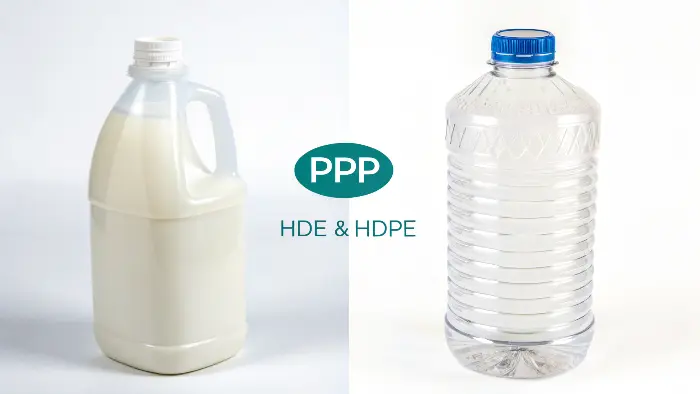
When you walk down a supermarket aisle, you are surrounded by a masterclass in material selection. The choice to use PP or HDPE for a bottle is never random; it’s a deliberate engineering decision based on the product’s needs.
Visual and Tactile Differences
The first thing a customer notices is how a bottle looks and feels.
- Clarity: This is a huge differentiator. Natural HDPE is a milky, translucent white. It’s great for hiding imperfections but you can’t see the product inside clearly. Natural PP, especially certain grades, can be made with excellent "contact clarity," meaning it’s almost clear when the product is inside. If you want your customer to see the rich color of your syrup or sauce, PP is the way to go.
- Feel: Pick up a milk jug (HDPE) and then a ketchup bottle (often PP). The HDPE feels softer and is easy to squeeze. The PP bottle feels harder, more rigid, and less pliable. This tactile feedback communicates a lot about the product inside.
Application-Specific Examples
The best way to understand the difference is to look at what these bottles are used for.
- HDPE Bottles: Think of milk jugs, detergent bottles, shampoo bottles, and industrial chemical jugs. The common themes here are excellent chemical resistance (it holds up to bleach and detergents), great impact strength (it can be dropped), and low cost. Squeezability is also a key feature for many shampoo and conditioner bottles.
- PP Bottles: Think of ketchup and syrup bottles, medicine bottles, and baby bottles. The key requirements here are heat resistance for hot-filling or sterilization, good clarity to see the product, and excellent fatigue resistance. That little plastic hinge on a flip-top cap is a "living hinge," a feature that PP is famous for.
| Application | Why HDPE? | Why PP? | The Deciding Factor |
|---|---|---|---|
| Milk Jug | Low cost, good barrier, impact strength. | Not needed, becomes brittle when cold. | Cost and cold performance. |
| Ketchup Bottle | Poor clarity, can’t handle heat. | Good clarity, hot-fill capable, rigid. | Heat resistance and clarity. |
| Detergent Bottle | Excellent chemical resistance, low cost. | Can be used, but often over-spec’d. | Chemical resistance and cost. |
| Baby Bottle | Cannot be sterilized with steam. | Excellent heat resistance for sterilization. | Safety and heat resistance. |
Think about a simple syrup bottle. It needs to be clear to show the product. It needs to handle being filled with hot syrup. The cap often has a living hinge. HDPE would fail on all of these points for this specific application. This is a perfect illustration of how the material’s properties directly dictate its use in the real world.
Conclusion
In the end, there is no single "best" material between HDPE and PP. The right choice is always the one that best fits the specific needs of your product. The decision comes down to a few key questions: Does it need to handle heat or cold? How important are stiffness and clarity? And what is the true cost-per-part? By carefully analyzing these factors, you can confidently select the right material for a successful, reliable, and cost-effective food container.
